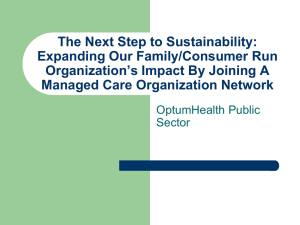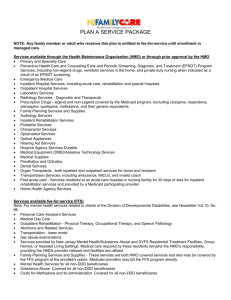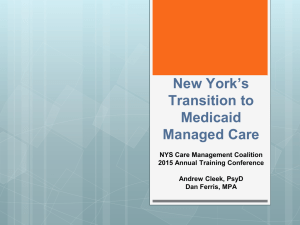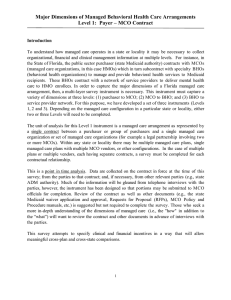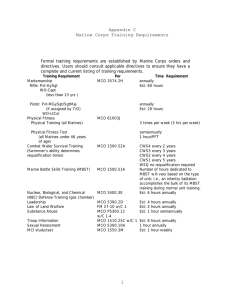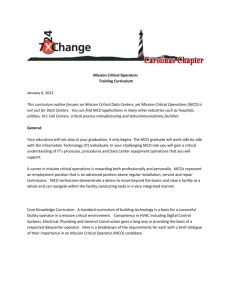Powerpoint
advertisement
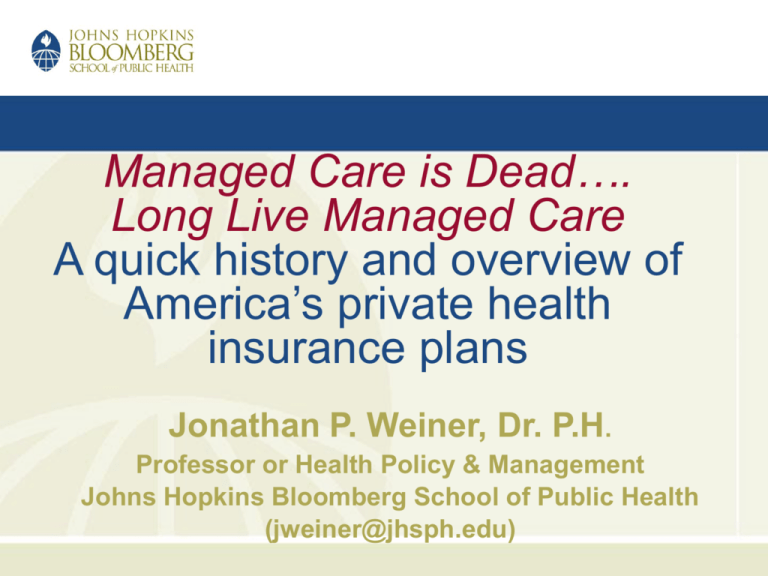
Managed Care is Dead…. Long Live Managed Care A quick history and overview of America’s private health insurance plans Jonathan P. Weiner, Dr. P.H. Professor or Health Policy & Management Johns Hopkins Bloomberg School of Public Health (jweiner@jhsph.edu) At lightning speed, this primer session will: • Provide a brief history and nuts-and-bolts overview of health insurance and managed care in the US. • Highlight some reasons for and effects of the recent “Managed Care Backlash.” • Help provide a context for understanding health care reform proposals presented at this conference. All slides copyright the Johns Hopkins University - 2008 2 Of course its all about the money -- US health care spending: 1962-2008 2500 Dollars (billions) 2000 1500 1000 500 0 1962 1966 1970 1974 1978 1982 1986 1990 1995 1998 2000 2008 Source: HCFA, CMS Year 3 Per capita health Spending ($PPP)* Health spending vs GDP in OECD nations: The US is the outlier 6500 6000 5500 5000 4500 4000 3500 3000 2500 2000 1500 1000 500 0 United States Belgium Luxembourg Australia Norway Switzerland Austria Iceland Canada France Germany Greece Czech Republic New Zealand Portugal Netherlands Ireland Italy Finland Spain Japan Slovak Republic Denmark Sweden United Kingdom Korea Hungary Poland Mexico Turkey 0 5 10 15 20 25 30 35 40 45 50 55 60 65 70 *Purchasing power parity Source: OECD in Figures, 2006, 2007 Per capita GDP (thousands $PPP)* 4 Alternative approaches for financing / organizing health care • Government employed providers • Government “social insurance” – Mandatory buy-in – Entitlement for special populations • As “benefit” of employment – Insurance – Direct care or access to contract providers • • • • Union/worker collectives Privately purchased health insurance Out of pocket / private pay Charity care 5 Proportion of Americans with health insurance: 1940-2008 100 90 70 60 50 40 30 20 10 20 08 20 00 19 95 19 90 19 80 19 75 19 70 19 65 19 60 19 55 19 50 19 45 0 19 40 % Insured 80 Year 6 US Health Insurance: Some Historical Highlights • 1930’s -- Blue-Cross/ Blue Shield and Hospital Association. • 1930’s – Prepaid-Group Practices (PGPs) and Union/Employers • 1950’s – Commercial insurers get into the act • 1960’s -- Federal “great society” – Medicare and Medicaid • 1970’s - The “Health Maintenance Organization” (HMO) Act (the unholy alliance of AMA sponsored IPAs and union friendly PGPs) 7 Why Employers Got Involved In Health Care in the US • Healthy employees are productive employees • European immigrant / union expectations • Tax advantage • Attracts good employees • Employers filled the vacuum in the 1930-50’s, (now “stuck” in this role). 8 Health Insurance Coverage in the U.S., 2006 Uninsured 16% EmployerSponsored Insurance 54% Medicaid/ Other Public 12% Medicare 14% Total = 296.1 million Private NonGroup 5% SOURCE: Kaiser Commission on Medicaid and the Uninsured/Urban Institute analysis of March 2007 CPS. 9 Most Americans get health insurance “privately,” but the public sector bankrolls almost half of all care (% Distribution of Personal Health Expenditures by Payer, 1980-2006) 70% 60% Private Funds 59.9 60.8 61.1 59.5 58.2 57.0 55.6 55.2 55.1 55.6 57.0 57.4 57.3 56.3 56.1 56.0 55.6 55.3 54.7 50% 40% 30% 45.3 44.9 44.4 43.0 44.4 44.8 43.0 42.6 42.7 43.7 43.9 44.0 44.4 44.7 41.8 40.5 40.1 39.2 38.9 Public Funds 20% 10% 06 20 05 20 04 20 03 20 02 20 01 20 00 20 99 19 98 19 97 19 96 19 95 19 94 19 93 19 92 19 91 19 90 19 85 19 19 80 0% . Source: Kaiser Family Foundation calculations using NHE data from Centers for Medicare and Medicaid Services, Office of the Actuary, National Health Statistics Group, 10 The Most Important Chart in this Presentation: (Private Health Insurance Premiums, Worker’s Earnings and General Inflation, 1988-2007) Health Insurance Premiums 20% 18% Workers' Earnings 18.0% Overall Inflation 16% 14% 13.9% 12.9%* 14.0% 12% 11.2%* 12.0% 10.9%* 10% 8.5% 8% 9.2%* 7.7%* 6.1%* 8.2%* 6% 5.3%* 4% 3.7% 2% . Source: Kaiser/HRET Survey of Employer-Sponsored Health Benefits, 1999-2007; 07 20 06 20 05 20 04 20 03 20 02 20 01 20 00 20 19 99 2.6% 98 19 19 96 19 95 19 94 19 93 19 92 19 91 19 90 19 89 19 88 19 97 0.8% 0% 11 The “Rise and Fall” of Managed Care is Embodied in this Trend Line In the late 1980’s the bankrollers of the system said enough was enough, and the era of “managed care” was born. HMOs and their techniques served as the model. 12 Managed Care Organization's Approximate Share of the Health Insurance Market in 1988 & 2008 1988 2008 FFS 15% MCO 25% FFS 75% FFS 75% MCO 25% MCO 85% FFS 15% MCO 85% 13 The US Health Insurance / “Managed Care” Models (and approx market share in 2008) • Traditional Fee-for Service (Unmanaged) – 15% (Mainly Medicare) • Preferred Provider Organization (PPO) and other “loose” managed care plans – 47% (includes “consumer defined health plans” / “high deductible health plans”) • Health Maintenance Organization (HMO) – 38% (includes “point of service” “open-HMO”) 14 The Key “Ingredients” of Managed Care • Care “management” – aka, utilization/disease management • Vertical integration / coordination of independent providers • Financial risk sharing with providers and consumers 15 Types of health plans have shifted over the years (employer based plans) 1988 73% 1993 46% 1996 27% 1999 2000 16% 31% 10% 2001 * 2002 * 14% 24% 42% 24% 21% 46% 23% 4% 27% 52% 18% 2003 5% 24% 54% 17% 2004 5% 25% 2005 *3% 55% 21% 2006 3% 20% 2007 3% 21% 0% 15% 61% 15% 60% 13% 57% 20% 40% 13% 60% Source: Kaiser/HRET Survey of Employer-Sponsored Health Benefits, 19992007; KPMG Survey of Employer-Sponsored Health Benefits, 1993, 1996; The Health Insurance Association of America (HIAA), 1988. * 7% 39% 29% 7% 26% 28% 28% 8% * 21% 11% 4% 5% 80% Conventional HMO PPO POS-HMO CDHP/HDHP 100% 16 Private managed care plans care for the majority of Medicaid / S-CHIP enrollees (Trends ‘90-’04) Enrollment (in millions) 50 45 40 25.3 28.3 30.9 33.4 33.6 33.4 33.2 32.1 30.9 31.9 33.7 36.6 40.1 35 30 25 20 15 23.0 25.6 27.3 28.6 25.8 23.6 19.9 0 2.3 2.7 3.6 4.8 1990 1991 1992 1993 7.8 9.8 1994 1995 14.3 14.2 14.9 13.3 15.3 16.6 17.8 18.8 20.8 1996 1997 1998 1999 2000 2001 10 5 16.7 15.8 17.0 42.7 17.5 44.4 17.4 23.1 25.3 26.9 2002 2003 2004 Number Enrolled in Traditional Medicaid Programs Number Enrolled in Medicaid Managed Care Source: KFF 17 Medicare’s Private MCO (“Medicare Advantage”) Enrollment has Waxed and Waned 35% 30% % of Beneficiaries in MCOs 25% 20% 15% 10% 5% 0% 1992 1994 1996 1998 2000 2002 2004 2006 2008 Source: CMS 18 The managed care backlash and public perceptions 19 US Consumer Perceptions 20 US Public’s Perception on Regulation and Managed Care 21 Consumers Don’t Really Understand Why Health Care Costs are Rising Percent who say each is a “one of the single biggest factors in rising health care costs”: 50% Drug/insurance companies making too much money Too many medical malpractice suits 37% Fraud and waste in the health care system 37% Doctors/hospitals making too much money 36% Administrative costs in handling insurance claims 30% People getting treatments they don’t really need 30% People needing more care due to unhealthy lifestyles 29% Use of expensive new drugs/treatments/technology 28% The aging population More people are getting better medical care 23% 12% SOURCE: ABC News/KFF/USA Today Health Care in America Survey (conducted September 7-12, 2006) 22 The “backlash” has not had much impact on MD / MCO financial relations (Trends in Physician Contracting and Managed Care Revenue, 1996-2005) 1996-97 1998-99 2000-01 2004-05 Physicians with No Managed Care Contracts 9.4% 8.6% 9.2% 11.5%* Average Number of Managed Care Contracts Among Physicians with ≥1 Managed Care Contract 12 13 13 13 Physicians with No Managed Care Revenue 5.7% 5.2% 5.8% 8.6%* Revenue from Managed Care Among Physicians with ≥1% Managed Care Revenue (Mean) 42% 45% 45% 44% *Change from 2000-2001 is statistically significant at p<.001. Source: Center for Studying Health System Change, Community Tracking Study 23 24 25 The three decades of private health insurance: The solutions must be here somewhere?? FFS MCO HMO Provider Dominance Open Access MCO Product Expansion Costs out of Control Consumer Driven HC We gotta try Something new MC Backlash 27


